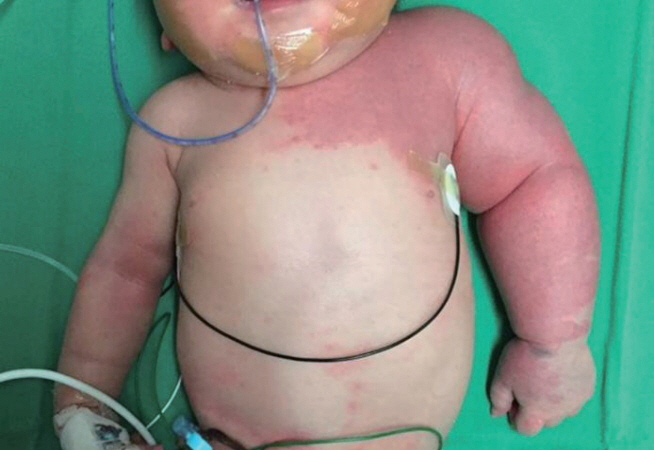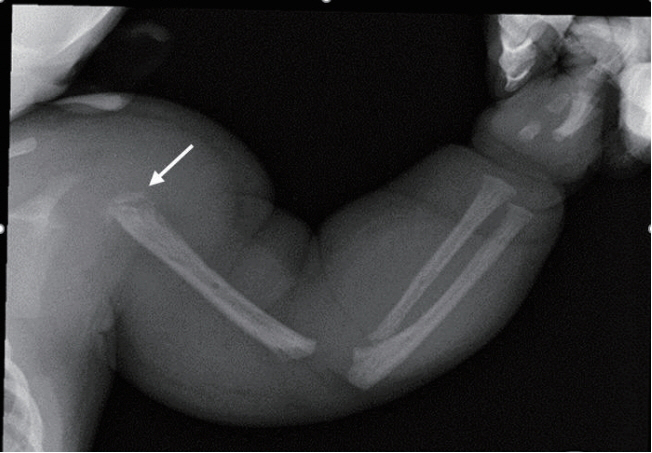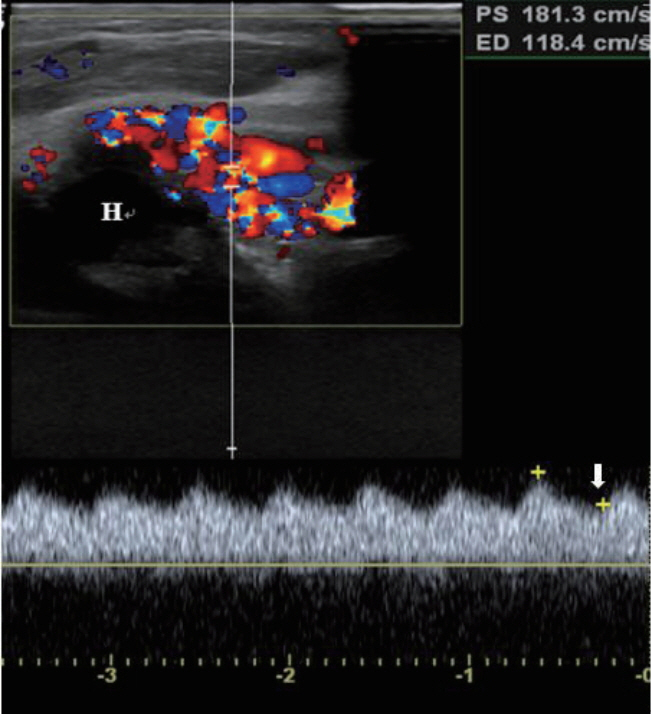Neonatal Med.
2018 Aug;25(3):126-130. 10.5385/nm.2018.25.3.126.
RASA1-Related Parkes Weber Syndrome in a Neonate
- Affiliations
-
- 1Department of Pediatrics, Cheil General Hospital & Women's Healthcare Center, Dankook University College of Medicine, Seoul, Korea. ykleeped@hanmail.net
- 2Department of Radiology, Cheil General Hospital & Women's Healthcare Center, Dankook University College of Medicine, Seoul, Korea.
- KMID: 2436129
- DOI: http://doi.org/10.5385/nm.2018.25.3.126
Abstract
- Parkes Weber syndrome is a rare congenital vascular anomaly, related to the RAS p21 protein activator 1 (RASA1) gene. It is characterized by capillary cutaneous malformations, bony and soft tissue hyperplasia, and multiple arteriovenous fistulas throughout the affected upper or lower extremity. These arteriovenous fistulas can be associated with life-threatening complications such as bleeding, thrombosis, and high output heart failure. In this report, we present a neonate who had a disproportionately hypertrophied left upper limb with port-wine stain, dystrophy of the left humerus, and hypertrophy of the left clavicle on X-ray, and arteriovenous malformation and massive dilatation of the left subclavian artery on magnetic resonance angiography. Exome sequencing analysis revealed a novel heterozygous splicing mutation (c.1776+2T>A) in the RASA1 gene. To the best of our knowledge, this report is the first case of RASA1-related Parkes Weber syndrome in Korea.
Keyword
MeSH Terms
Figure
Reference
-
1. Parkes Weber F, Liang MG. Angioma: formation in connection with hypertrophy of limbs and hemi-hypertrophy. Br J Dermatol. 1907; 19:231–5.2. Maguiness SM, Liang MG. Management of capillary malformations. Clin Plast Surg. 2011; 38:65–73.3. Nozaki T, Nosaka S, Miyazaki O, Makidono A, Yamamoto A, Niwa T, et al. Syndromes associated with vascular tumors and malformations: a pictorial review. Radiographics. 2013; 33:175–95.4. Enjolras O, Chapot R, Merland JJ. Vascular anomalies and the growth of limbs: a review. J Pediatr Orthop B. 2004; 13:349–57.5. Eerola I, Boon LM, Mulliken JB, Burrows PE, Dompmartin A, Watanabe S, et al. Capillary malformation-arteriovenous malformation, a new clinical and genetic disorder caused by RASA1 mutations. Am J Hum Genet. 2003; 73:1240–9.6. Gloviczki P, Duncan A, Kalra M, Oderich G, Ricotta J, Bower T, et al. Vascular malformations: an update. Perspect Vasc Surg Endovasc Ther. 2009; 21:133–48.7. Adekanmi AJ, Schernthaner RE, Lammer J. Parkes Weber syndrome: a rare vascular malformation-imaging and the usefulness of intravascular intervention. Internet J Radiol. 2015; 18:1–7. https://doi.org/10.5580/IJRA.24813.8. Hershkovitz D, Bergman R, Sprecher E. A novel mutation in RASA1 causes capillary malformation and limb enlargement. Arch Dermatol Res. 2008; 300:385–8.9. Revencu N, Boon LM, Mulliken JB, Enjolras O, Cordisco MR, Burrows PE, et al. Parkes Weber syndrome, vein of Galen aneurysmal malformation, and other fast-flow vascular anomalies are caused by RASA1 mutations. Hum Mutat. 2008; 29:959–65.10. Behr GG, Liberman L, Compton J, Garzon MC, Morel KD, Lauren CT, et al. CM-AVM syndrome in a neonate: case report and treatment with a novel flow reduction strategy. Vasc Cell. 2012; 4:19.11. Banzic I, Brankovic M, Maksimovic Z, Davidovic L, Markovic M, Rancic Z. Parkes Weber syndrome-diagnostic and management paradigms: a systematic review. Phlebology. 2017; 32:371–83.12. Ziyeh S, Spreer J, Rossler J, Strecker R, Hochmuth A, Schumacher M, et al. Parkes Weber or Klippel-Trenaunay syndrome? Non-invasive diagnosis with MR projection angiography. Eur Radiol. 2004; 14:2025–9.13. Jamis-Dow CA, Turner J, Biesecker LG, Choyke PL. Radiologic manifestations of Proteus syndrome. Radiographics. 2004; 24:1051–68.14. Paltiel HJ, Burrows PE, Kozakewich HP, Zurakowski D, Mulliken JB. Soft-tissue vascular anomalies: utility of US for diagnosis. Radiology. 2000; 214:747–54.15. Lobo-Mueller E, Amaral JG, Babyn PS, Wang Q, John P. Complex combined vascular malformations and vascular malformation syndromes affecting the extremities in children. Semin Musculoskelet Radiol. 2009; 13:255–76.16. Kulkarni SV, Gish G, van der Geer P, Henkemeyer M, Pawson T. Role of p120 Ras-GAP in directed cell movement. J Cell Biol. 2000; 149:457–70.17. Triana P, Dore M, Cerezo VN, Cervantes M, Sanchez AV, Ferrero MM, et al. Sirolimus in the treatment of vascular anomalies. Eur J Pediatr Surg. 2017; 27:86–90.






